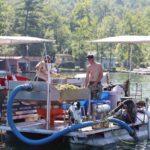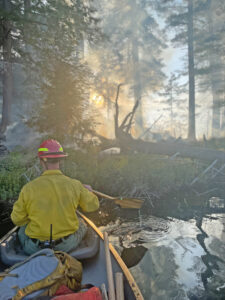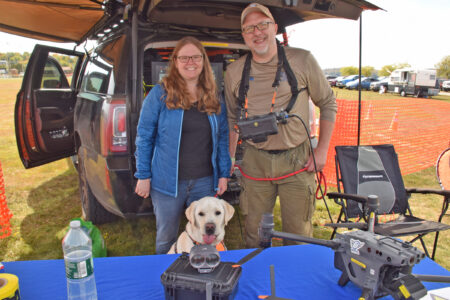Invasive aquatic plants get sucked up at Lake George
- John Thouin, an environmental analyst with the Lake George Park Commission, snorkels to search for Eurasian watermilfoil in Lake George Wednesday, Sept. 5. (Photo — Gwendolyn Craig, The Post-Star)
- Dave Wick, executive director of the Lake George Park Commission, holds a sprig of invasive Eurasian watermilfoil found in Lake George Wednesday, Sept. 5. (Photo — Gwendolyn Craig, The Post-Star)
- Members of AE Commercial Diving Services use a vacuum to suck up invasive Eurasian watermilfoil from Lake George Wednesday, Sept. 5. (Photo — Gwendolyn Craig, The Post-Star)
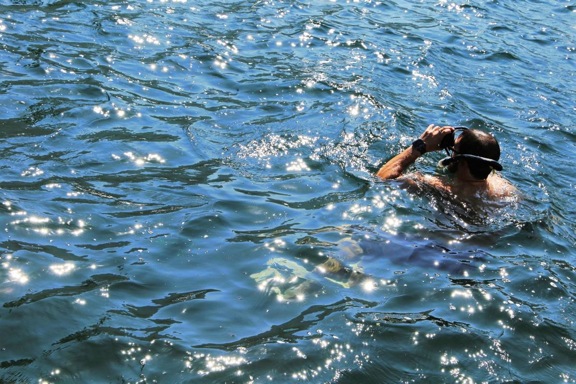
John Thouin, an environmental analyst with the Lake George Park Commission, snorkels to search for Eurasian watermilfoil in Lake George Wednesday, Sept. 5. (Photo — Gwendolyn Craig, The Post-Star)
Ben Sheldon and his AE Commercial Diving crew have been vacuuming parts of Lake George this summer.
It’s a method the Lake George Park Commission has decided to try out for removing Eurasian watermilfoil. The invasive aquatic plant has been growing in Lake George for decades, first spotted in Northwest Bay in 1986, said David Wick, executive director of the park commission.
Milfoil are rooted plants with whorled leaves that can form dense canopies, blocking out light for other native plants, according to the federally sponsored Aquatic Nuisance Species Task Force. They can choke out water bodies, restricting swimming, boating and even clogging water intake pipes. Particularly dense areas may also provide good habitat for breeding mosquitoes.
The park commission and partners have used lake bottom mats to smother out the plant and pulled them by hand. This year, managers are putting a twist on the hand-pulling method by using a vacuum.
Sheldon said some observers think they are dredging the lake bottom, but they are not. Instead, a diver goes down into the lake and hand pulls the plant, which then gets sucked up by the vacuum. The hose transfers it to the surface, and it’s shot out into a sorting area on the divers’ boat.
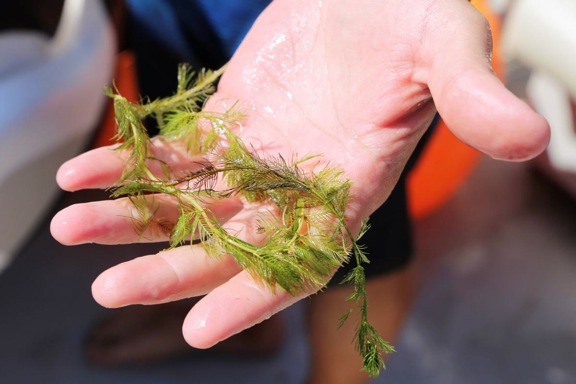
Dave Wick, executive director of the Lake George Park Commission, holds a sprig of invasive Eurasian watermilfoil found in Lake George Wednesday, Sept. 5. (Photo — Gwendolyn Craig, The Post-Star)
The team was working off of Huletts Landing in the town of Dresden Wednesday, Sept. 5, and planned to work on a few more sites, including Finkle Brook and Northwest Bay in the Bolton area.
“It seems to be working pretty well,” Wick said.
One of the advantages of the vacuum, Sheldon said, is it keeps divers’ visibility clear. Wick said toward the end of summer, milfoil tends to break apart more easily, clouding the water. Shooting it up the hose gets the plant material out of the water more efficiently, and the operation occurs away from the boat’s propeller so none of it gets mixed into the water.
The material that’s collected gets offloaded and delivered to the Lake George or Bolton landfills.
The crew can pull out a little over 2,000 pounds of milfoil in one day, Sheldon said. They’ve been working on the lake since June and plan to present a report to the park commission on this season’s efforts likely in October.
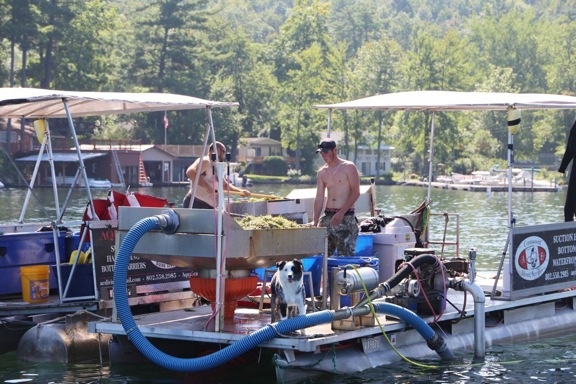
Members of AE Commercial Diving Services use a vacuum to suck up invasive Eurasian watermilfoil from Lake George Wednesday, Sept. 5. (Photo — Gwendolyn Craig, The Post-Star)



